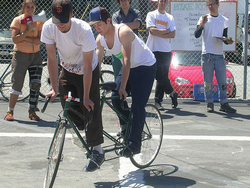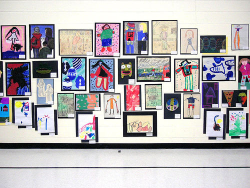Social Networking
Social Networking

Image by aqhong (Access 10/12/2009)
Short description
Social networking sites are websites where users create personal profiles and connect with each other. The idea behind the sites is to link up with your friends and see who they are friends with and their friends’ friends.
Process description
Social networking sites excel at creating and highlighting social connections. You can usually send massages to and chat with other users, and some sites allow you to create personalized webspaces. Facebook, MySpace, and LinkedIn are some of the common examples.
When used for learning, the easy communication and connectivity of such sites can be helpful in supporting and strengthening connections between both the teacher and students and between students.
One use for social networking sites is to set up collaborative problem solving. By allowing the students to discuss a problem with each other they can bounce idea off of each other and find a solution together. This use of social networking is likely already happening, with students discussing course related subjects among themselves. By participating in or directing this discussion, a teacher can influence the discussion and assist if the problems prove too difficult.
Another use is as a way to share files and news quickly. If someone has a file that the rest of the course could use, they can quickly share it with the rest. Mind the copyrights when doing this, though. This can also be used by teachers to share course material and slides. Some schools and universities are already doing this, including official Facebook and MySpace pages, Youtube channels, and official presences in online games like Second Life.
Social networking sites can also be used to allow the students to create profiles and establish their course identity with new profiles created specifically for the course, either as a part of the course, or because the students want to keep their private profile separate from their course profile.
Required resources
You will need an internet connection and the course participants will all need to be members of the same social networking site. With younger students, this is likely already the case. You will also need to be somewhat proficient in the chosen social networking site if you want to participate in the social networking yourself.
Examples
A good reason to use social networking sites in learning is that many younger students are already avid users of social networking sites, and are used to communicating like that.
Social Networking in plain English:
Comments
This example is developed in relation to the two EU projects COMBLE (https://www.comble-project.eu/).
PSI: https://psi.methopedia.eu/learning-activity/social-networking
Spinnennetz
Spinnennetz

Foto von Jus' fi (abgerufen am 30.09.2009)
Kurzbeschreibung
Ohne das Spinnennetz zu berühren, passieren die Teilnehmer verschiedene Öffnungen im Netz. Andere Teilnehmer helfen, denn es handelt sich um eine Gruppenübung.
Ablauf
Seile spannen.
Die Teilnehmer überwinden das Netz, indem sie durch verschiedene Felder krabbeln, steigen, hüpfen ...
Zusatzregeln:
Es darf keine Öffnung zweimal verwendet werden.
Durch das Netz darf nicht gegriffen werden.
Bei Berührung wird noch mal begonnen.
Benötigte Tools und Materialien
Offline:
Mehrere Seile oder starke Schnüre zum Knüpfen eines Spinnennetzes.
Beispiele und Links
Kommentare
Diese Übung schult die Zusammenarbeit innerhalb einer Gruppe. Im Freien müssen Bäume vorhanden sein, die dicht beieinander stehen.
Subject Sampler
Subject Sampler

Image by neofob (Access: 01.10.2009)
Short description
In a Subject Sampler learners are presented with a smaller number (maybe half a dozen) of intriguing Web sites organized around a main topic. They are asked to visit the sites and respond to information found there. The selected sites can include photographs, art, music, text, and a variety of other types of information. What makes this a particularly effective way to engage students is that the teacher has chosen Web sites themselves that offer something interesting to do, read, or see about a given topic. Teachers can use a Subject Sampler when they want students to feel connected to the topic, to get emotionally involved in the topic, and to feel that the topic really matters.
Process description
Teacher create list of Internet sites for students.
Students are asked to respond to the Web-based activities from a personal perspective (their perspectives on topics, comparisons to experiences they have had, personal interpretations of artworks or data, etc.)
Required resources
Computer, Internet
PSI: https://psi.methopedia.eu/learning-activity/subject-sampler
Tandem-Lernen
Tandem-Lernen

Foto von unaesthetic (abgerufen am 30.09.2009)
Kurzbeschreibung
Zwei Personen lernen zusammen ein Thema.
Ablauf
Zunächst Gruppen bilden, dann eine Zeitvorgabe machen, z. B.: Sie haben 10 Minuten Zeit. Was kann zusammen gelernt werden?
Möglichkeit: Die beiden Lernenden sollen sich zusammen den Inhalt einer Lerneinheit erarbeiten.
Möglichkeit: Sie lösen zusammen die gestellten Aufgaben.
Benötigte Tools und Materialien
Keine besonderen
Beispiele und Links
Kommentare
Wenn zwei Programmierer vor einem Rechner sitzen und zusammen eine Software entwickeln, so nennt man das Extreme Programing. Vier Augen sehen mehr als zwei, zwei Gehirne denken mehr als eins! Jederman kann voneinander lernen und schneller Lösungen finden.
Teilnehmergalerie
Teilnehmergalerie

Foto von striatic (abgerufen am 16.10.2009)
Kurzbeschreibung
Die Teilnehmer lernen sich mit Hilfe der Online-Lernplattform kennen.
Ablauf
Vor einer Kursleiterfortbildung, sei es ein Seminar, eine Folge von Einzelveranstaltungen oder eine onlinebasierte Aktion, gestaltet der Moderator eine Galerie auf einem Server oder einer Kommunikations- bzw. Lernplattform, die allen Teilnehmerinnen und Teilnehmern zugänglich ist.
Dort stellen die Moderatorinnen und Moderatoren sich persönlich vor (am besten mit Foto) und teilen in der gebotenen Kürze all das mit, was sie für wichtig halten (z. B. ihre Vorstellungen zur gemeinsamen Arbeit, Organisationshinweise usw.)
Anschließend sammelt das Moderator Daten der Teilnehmer (Name, Fotos und was sonst noch interessant sein könnte) und stellt dies in die Galerie ein. Bei entsprechenden technischen Voraussetzungen machen das die Teilnehmer selbst. Bei einer Direktphase (face-to-face) sollten Fotos und Daten ausgedruckt oder als Wandbilder vorliegen. Die Daten lassen sich später ergänzen. Neue Teilnehmer werden nach und nach in die Teilnehmergalerie aufgenommen.
Benötigte Tools und Materialien
Online:
Computer
Internetanschluss
Lernplattform
Beispiele und Links
Noch keine. Hilf mit hier ein Beispiel einzustellen. Melde dich bei Methopedia!
Kommentare
Das Verfahren erleichtert und beschleunigt die Kennenlernphase und trägt dazu bei, dass die Teilnehmer bereits im Vorfeld auf die Fortbildung und die Nutzung von Computer und Internet eingestimmt werden.
PSI: https://psi.methopedia.eu/learning-activity/usergallery
Test questions
Test questions

Image by Ben+Sam (Access: 18.04.2011)
Short description
Allow students to write test questions and model answers for specified topics, in a format consistent with course exams. This will give students the opportunity to evaluate the course topics, reflect on what they understand, and what are good test items.
Process description
Make a rough tally of the questions your students propose and the topics that they cover.
Evaluate the questions and use the goods ones as prompts for discussion.
You may also want to revise the questions and use them on the upcoming exam.
Required resources
None

Image by Roo Reynolds (Access: 15.12.2009)
Short description
A new way to engage students through social software – the possibilities of Twitter as a tool for communication and reflection.
Process description
Each participant signs up on twitter.com with a username.
Depending on the purpose of using Twitter in class the facilitator should make a hashtag # to label the course. It could be #ILS09 or #coursename.
During the course you should ask the students for a number of tweets for each lecture and tag it with the hashtag.
The result of using Twitter in educational settings is a back channel for communication and reflection among students and teachers. Here discussions can be facilitated and you can follow up on different areas of interest.
It is important that you make at clear what the purpose of using Twitter is and how many tweets you expect from each students to start the process of making twitter a part of your teaching.
Required resources
Laptops, internet connection and a Twitter account.
Examples
Currently I am co-teacher at course called ICT, learning and collaboration where four students are participating and a remark from that experience is that it is difficult to facilitate discussion. We believe that there would be more activity on twitter - re-tweets, direct messages etc. - if the student were a bit large.
It is also difficult to assess the activity in a qualitative manner because you cannot control the structure and level of reflection on Twitter. You have to require a number of tweets and that seems like the only way to evaluate the student’s activity right now.
Comments
Twitter is also a type of informal learning.
This example is developed in relation to the two EU projects COMBLE (https://www.comble-project.eu/)
Videobridge
Videobridge

Image by vectorfunk (Access: 15.12.2009)
Short description
Videobridge is about affordable, interactive group communication possibilities by high quality video links - specifically for rural and remote learners.
Process description
The VideoBridge project aims to realize permanently available cheap group communication possibilities, preferably live and in both directions with high quality video/audiostreams via the internet.
The term "videobridge" instead of "videoconferencing" signifies that there is something happening at local scale, which we are simply enhancing (or enabling) by a "bridge" (while a videoconference is primarily an event in virtual space).
Required resources
Computers
Cameras
Sound Systems
Projectors
Microphones
Mixers
Examples
Virtual Trips: http://www.uen.org/Lessonplan/preview.cgi?LPid=22080
Comments
Streaming, Sharing and Learning (SSL) – The options for and the use of Interactive Digital Video over long distances in adult education.
Grundtvig Workshop in Vienna, January 2010 - Applications welcome!
PSI: https://psi.methopedia.eu/learning-activity/video-bridge
Virtual Field Trip
Virtual Field Trip

Image by Alex '77 (Access: 01.10.2009)
Short description
Virtual field trips are designed to be entertaining and educational. Virtual field trips provide opportunities for new discovery in the classroom. The virtual fieldtrip may be created prior to an actual trip the students will be making. In this way teachers can prepare students for the adventure they will have. This allows the teacher to focus on particular points of interest that the students should key in on. Teachers can create a virtual field trip using Microsoft Word, Powerpoint, or a web page.
The teacher chooses various sites that students will visit that pertain to the chosen topic. At each site (stop along the journey) or after a visit to several sites, the students will complete an activity or create a "souvenir" at the field trip stop.
Process description
Teacher prepares a tour and tourguide for students (for each tour stop that explains what the students are to do).
The activities may be an interactive experience at the particular site, writing in a journal, making a booklet of information, sending a post card about the stop, etc.
Students use the information they find at the various sites along the virtual tour.
Older students may be given the task of creating a virtual field trip about a given topic.
Required resources
Computer, Internet
Examples
Education World’s The Human Body Online Tour: http://www.education-world.com/a_lesson/lesson065.shtml
PSI: https://psi.methopedia.eu/learning-activity/virtual-field-trip



Social Bookmarking
Image by inju (Access: 12.11.2009)
Short description
Social bookmarking is a way to share internet bookmarks with others. They work more or less like the bookmarks in a web browser, except you share them for others to see and use.
Process description
Like standard web bookmarks, the social bookmark is only a link to the content, not the content itself. To create a social bookmark you create an account on a social bookmarking website, and start adding links to your profile. Usually, these social bookmarking sites will have a plugin for your web browser to make this easier to do.
Social bookmarking for learning can be used in a setting where all the students subscribe to the teacher’s bookmarks and get all the links and references that the teacher adds. That way, everyone has the same links and online materials. Expanding on that, the students can make bookmarks of their own and share them with each other, creating a social bookmarking network. This network can be used to find many websites relating to the subject and can become a solid collection of information.
By subscribing to each other, you can share interesting sites with each other and help each other catch useful web links that you might otherwise have missed. This can also be useful in an administrative fashion where if you find something that would be useful to someone else, you can social bookmark it.
You can also add so-called "tags" to you links. With the tags, your bookmarks become easy to find both for you and the people you share it with as it’s possible to search for these tags, both on your own and others’ profiles. It is also possible to subscribe to other people’s bookmarks, allowing you to instantly see when they add a new link to their profile.
Required resources
You will need an internet connection and an account on at least one social bookmarking website.
Comments
This example is developed in relation to the two EU projects COMBLE (https://www.comble-project.eu/).
PSI: https://psi.methopedia.eu/learning-activity/social-bookmarking